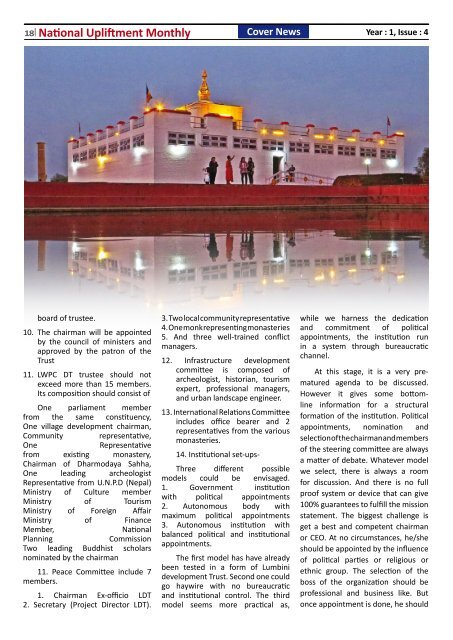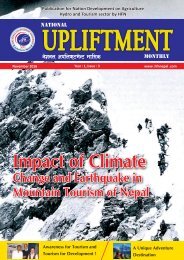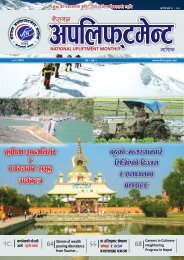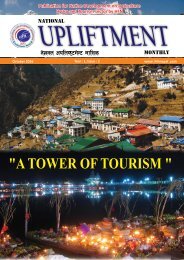You also want an ePaper? Increase the reach of your titles
YUMPU automatically turns print PDFs into web optimized ePapers that Google loves.
18<br />
<strong>National</strong> <strong>Upliftment</strong> <strong>Monthly</strong> Cover News<br />
Year : 1, Issue : 4<br />
board of trustee.<br />
10. The chairman will be appointed<br />
by the council of ministers and<br />
approved by the patron of the<br />
Trust<br />
11. LWPC DT trustee should not<br />
exceed more than 15 members.<br />
Its composition should consist of<br />
One parliament member<br />
from the same constituency,<br />
One village development chairman,<br />
Community representative,<br />
One<br />
Representative<br />
from existing monastery,<br />
Chairman of Dharmodaya Sahha,<br />
One leading archeologist<br />
Representative from U.N.P.D (Nepal)<br />
Ministry of Culture member<br />
Ministry of Tourism<br />
Ministry of Foreign Affair<br />
Ministry of Finance<br />
Member,<br />
<strong>National</strong><br />
Planning<br />
Commission<br />
Two leading Buddhist scholars<br />
nominated by the chairman<br />
11. Peace Committee include 7<br />
members.<br />
1. Chairman Ex-officio LDT<br />
2. Secretary (Project Director LDT).<br />
3. Two local community representative<br />
4. One monk representing monasteries<br />
5. And three well-trained conflict<br />
managers.<br />
12. Infrastructure development<br />
committee is composed of<br />
archeologist, historian, tourism<br />
expert, professional managers,<br />
and urban landscape engineer.<br />
13. International Relations Committee<br />
includes office bearer and 2<br />
representatives from the various<br />
monasteries.<br />
14. Institutional set-ups-<br />
Three different possible<br />
models could be envisaged.<br />
1. Government institution<br />
with political appointments<br />
2. Autonomous body with<br />
maximum political appointments<br />
3. Autonomous institution with<br />
balanced political and institutional<br />
appointments.<br />
The first model has have already<br />
been tested in a form of Lumbini<br />
development Trust. Second one could<br />
go haywire with no bureaucratic<br />
and institutional control. The third<br />
model seems more practical as,<br />
while we harness the dedication<br />
and commitment of political<br />
appointments, the institution run<br />
in a system through bureaucratic<br />
channel.<br />
At this stage, it is a very prematured<br />
agenda to be discussed.<br />
However it gives some bottomline<br />
information for a structural<br />
formation of the institution. Political<br />
appointments, nomination and<br />
selection of the chairman and members<br />
of the steering committee are always<br />
a matter of debate. Whatever model<br />
we select, there is always a room<br />
for discussion. And there is no full<br />
proof system or device that can give<br />
100% guarantees to fulfill the mission<br />
statement. The biggest challenge is<br />
get a best and competent chairman<br />
or CEO. At no circumstances, he/she<br />
should be appointed by the influence<br />
of political parties or religious or<br />
ethnic group. The selection of the<br />
boss of the organization should be<br />
professional and business like. But<br />
once appointment is done, he should





